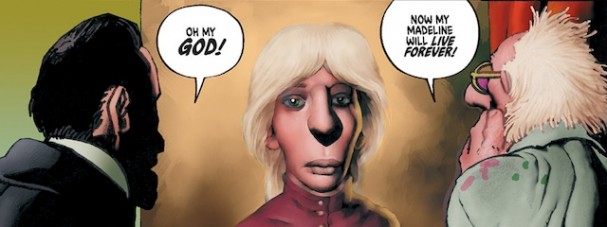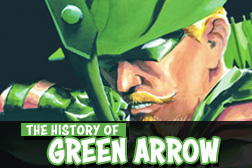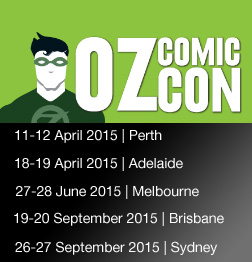Don’t have time for full reviews of comics? Then check out Graphic Bits: bite sized chunks of comic book goodness designed to get behind the panels and into your hearts.
This week (15 May 2013) is another big one! First up, we check in with Age of Ultron #8 (Marvel) just as it loses the plot. Then it’s back to the 1970s for some classic Battlestar Galactica #1 (Dynamite), opening up the sleeping life in Dream Merchant #1 (Image), Richard Corben’s take on Edgar Allan Poe’s The Fall of the House of Usher #1 (Dark Horse) and fizzling off into space with kid Nova #4 (Marvel). This is Graphic Bits.
Other reviews…Don’t forget, each week we also feature other outstanding or high-profile issues in their own reviews. Check out full reviews for Dream Thief #1 (Dark Horse) and Avengers: The Enemy Within #1 (Marvel).
Age of Ultron #8 (of 10) – Marvel, Brian Michael Bendis (writer), Brandon Peterson (artist). Rating: ★★½
 Now this is just getting silly. Or as Tony Stark puts it, “a Fantasia of insanity”. Set entirely in the altered future brought about by AU Wolverine and Susan Reed killing Hank Pym in the past, where we also spent last issue, Bendis has begun to repeat many of the earlier sins in the series. He has merely transplanted them to a new setting. The Age of Ultron they were so desperate to eradicate now seems to be a distant memory, but this doesn’t mean that Avengers (or in this case, the Defenders) can’t still squabble pointlessly for pages upon pages in alt.2013. Yet the real shame is that this has been one of the stronger issues of the series since the deceptively strong opening, and Bendis’s alternate present is one that comes with some intriguing concepts. Yet it’s another story entirely, with plotting that follows the unconventional wisdom that if you just keep up the illusion of movement, nobody will notice that we are simply being shown a slideshow of cool “stuff”. Pacing and plotting are just al over the place, as if every idea Bendis has been concocting over the last few years has been upended and tipped into a 10-issue series. One half expects an “it was all a dream” ending at this point, simply because every other plot device has been pulled out in the pursuit of “shock” endings. Peterson tackles art duties for the entire issue, and while there are some nice moments, it is a little inconsistent. We do particularly like the way that alt.Tony Stark is drawn, a twisted man-machine that is impossible to look away from. The only thing we are really expecting from the last two issues now is somehow tying this back to Age of Ultron before the inevitable follow-up series that this was all a massive advertisement for.
Now this is just getting silly. Or as Tony Stark puts it, “a Fantasia of insanity”. Set entirely in the altered future brought about by AU Wolverine and Susan Reed killing Hank Pym in the past, where we also spent last issue, Bendis has begun to repeat many of the earlier sins in the series. He has merely transplanted them to a new setting. The Age of Ultron they were so desperate to eradicate now seems to be a distant memory, but this doesn’t mean that Avengers (or in this case, the Defenders) can’t still squabble pointlessly for pages upon pages in alt.2013. Yet the real shame is that this has been one of the stronger issues of the series since the deceptively strong opening, and Bendis’s alternate present is one that comes with some intriguing concepts. Yet it’s another story entirely, with plotting that follows the unconventional wisdom that if you just keep up the illusion of movement, nobody will notice that we are simply being shown a slideshow of cool “stuff”. Pacing and plotting are just al over the place, as if every idea Bendis has been concocting over the last few years has been upended and tipped into a 10-issue series. One half expects an “it was all a dream” ending at this point, simply because every other plot device has been pulled out in the pursuit of “shock” endings. Peterson tackles art duties for the entire issue, and while there are some nice moments, it is a little inconsistent. We do particularly like the way that alt.Tony Stark is drawn, a twisted man-machine that is impossible to look away from. The only thing we are really expecting from the last two issues now is somehow tying this back to Age of Ultron before the inevitable follow-up series that this was all a massive advertisement for.
Battlestar Galactica #1 – Dynamite, Dan Abnett, Andy Lanning (writers), Cezar Razek (artist). Rating: ★★★½
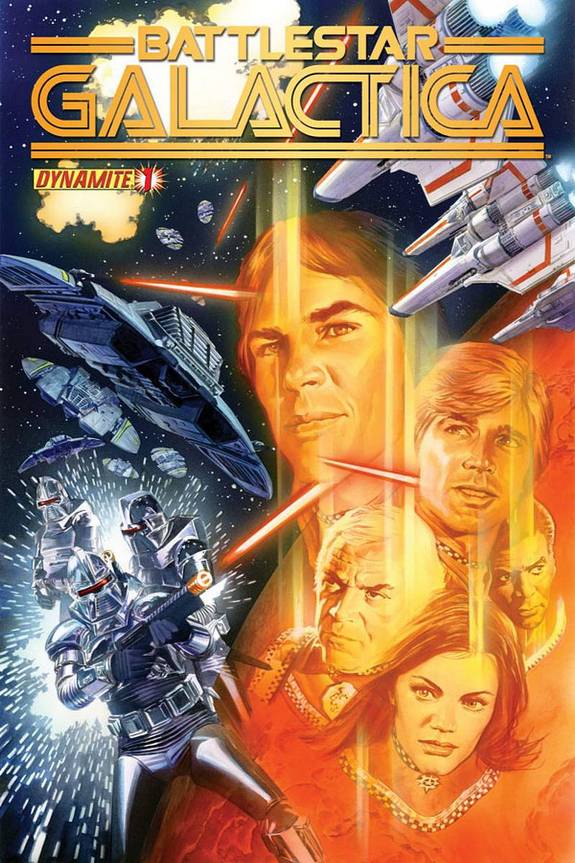 Those hoping for a comic book follow-up to the recent series, or even something continuing the prematurely aborted Caprica, may be disappointed to find that this is based on the original Glen A. Larson series from the 1970s. Yet it’s still a great licence for Dynamite to keep exploiting, not least of which when sci-fi masters Dan Abnett and Andy Lanning (collectively known as DnA) are aboard for their take on this series. On the surface, there is very little new about the issue, with humans and Cylons going head-to-head in space. DnA mirror their Guardians of the Galaxy approach of throwing us in the middle of the action, but they don’t take reader knowledge for granted either. Those unfamiliar with the original series are given more than enough information to springboard into this issue, and a few temporal surprises may ultimately mean some very interesting happenings in the second issue. Razek captures the essence of the show as well, taking what would now be the dated look of those original sets and costume designs and tweaking them just enough to look slick for the 21st century. There’s also some terrific action sequences. For fans, this is a no-brainer.
Those hoping for a comic book follow-up to the recent series, or even something continuing the prematurely aborted Caprica, may be disappointed to find that this is based on the original Glen A. Larson series from the 1970s. Yet it’s still a great licence for Dynamite to keep exploiting, not least of which when sci-fi masters Dan Abnett and Andy Lanning (collectively known as DnA) are aboard for their take on this series. On the surface, there is very little new about the issue, with humans and Cylons going head-to-head in space. DnA mirror their Guardians of the Galaxy approach of throwing us in the middle of the action, but they don’t take reader knowledge for granted either. Those unfamiliar with the original series are given more than enough information to springboard into this issue, and a few temporal surprises may ultimately mean some very interesting happenings in the second issue. Razek captures the essence of the show as well, taking what would now be the dated look of those original sets and costume designs and tweaking them just enough to look slick for the 21st century. There’s also some terrific action sequences. For fans, this is a no-brainer.
Dream Merchant #1 – Image Comics, Nathan Edmondson (writer), Konstantin Novosadov (artist). Rating: ★★★★
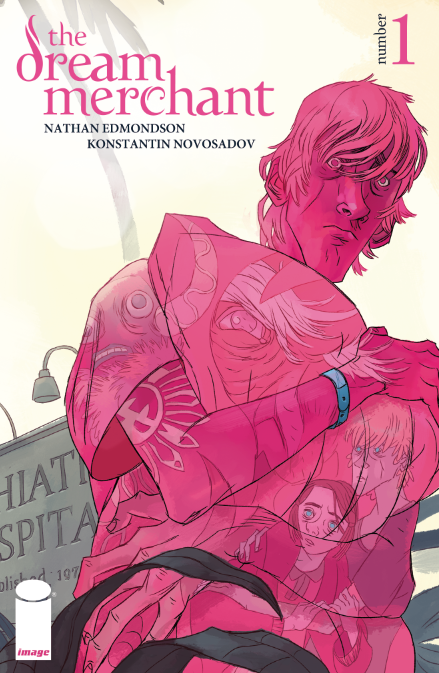 Not to be confused with Dream Thief, also out this week, for this is something entirely different. Plagued all of his life by an intense recurring dream, Winslow places himself in a mental institution, no longer convinced that his waking life is real. When he finds himself on the run with cafeteria worker Anne, one of the few people that has befriended him, it seems that Winslow’s dream may actually have more weight to them than he had always believed. The line between dream and reality is something that comic books have always dealt with, and here Nathan Edmondson more than makes up for his unfortunate run on Grifter. Edmondson steadily plots his first issue, neither giving us all of the information at once, nor holding back on us simply to create artificial drama. Indeed, by the end of this book, we have simply been set up to enjoy the further adventures of Winslow and Anne, the latter also being given sufficient back-story to warrant further exploration. Russian newcomer Konstantin Novosadov, who has really only done some work for small European publishers, makes his debut with Dream Merchants, although you wouldn’t believe this was his first trip out. Apparently drawing his influences from the likes of Guy Davis to Gustave Dore, his line-art is a distinctive mix that is perfectly suited to the nightmares and dreamscapes of this title. Image have been knocking out one solid debut after another this year, and while it may be a little too early to call this as the next big hit of the year, its strength certainly puts it on the right path.
Not to be confused with Dream Thief, also out this week, for this is something entirely different. Plagued all of his life by an intense recurring dream, Winslow places himself in a mental institution, no longer convinced that his waking life is real. When he finds himself on the run with cafeteria worker Anne, one of the few people that has befriended him, it seems that Winslow’s dream may actually have more weight to them than he had always believed. The line between dream and reality is something that comic books have always dealt with, and here Nathan Edmondson more than makes up for his unfortunate run on Grifter. Edmondson steadily plots his first issue, neither giving us all of the information at once, nor holding back on us simply to create artificial drama. Indeed, by the end of this book, we have simply been set up to enjoy the further adventures of Winslow and Anne, the latter also being given sufficient back-story to warrant further exploration. Russian newcomer Konstantin Novosadov, who has really only done some work for small European publishers, makes his debut with Dream Merchants, although you wouldn’t believe this was his first trip out. Apparently drawing his influences from the likes of Guy Davis to Gustave Dore, his line-art is a distinctive mix that is perfectly suited to the nightmares and dreamscapes of this title. Image have been knocking out one solid debut after another this year, and while it may be a little too early to call this as the next big hit of the year, its strength certainly puts it on the right path.
The Fall of the House of Usher #1 (of 2) – Dark Horse, Richard Corben (writer/artist). Rating: ★★★★½
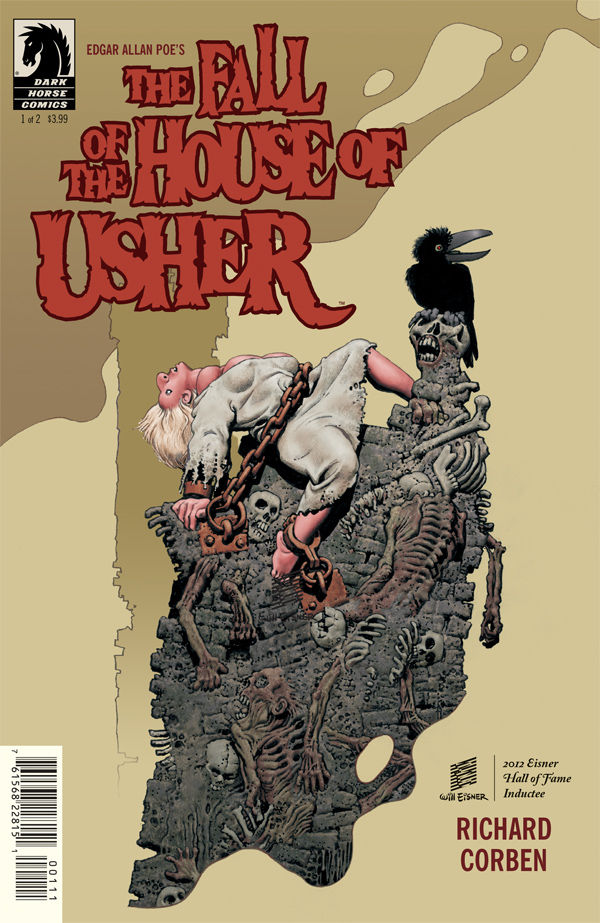 Richard Corben is no stranger to Edgar Allan Poe, having previously released Haunt of Edgar Allen Poe for Marvel MAX in 2006, and The Conqueror Worm for Dark Horse last year. Indeed, this isn’t the first time he has adapted The Fall of the House of Usher, which he did back in 1985 in a series of tales with artist Richard Margopoulos. This time out, he combines the narrative with The Oval Portrait, something he points out in his postscript notes had been done in the 1928 Jean Epstein film La Chute de la maison Usher. As such, this doesn’t have quite the same methodical plotting that Poe is know for, but it does manage to bring something fresh to a tale of mystery and imagination that has been reprinted and retold countless times over. Some of the language is completely faithful to the original text, while other liberties have been taking in making the speech more accessible to modern audiences. Richard Corben’s art, which earned him a place in the Will Eisner Award Hall of Fame last year, is masterful. He brings his Heavy Metal aesthetic, honed through years of Eerie and Creepy, and creates something that is both entirely Poe and unmistakably his own. Like a trade or hardcover collection, which this will ultimately work best as, Corben has also including quite a few sketches and notes at the end of this issue, and they are both fascinating and illuminating. While this may have made a better single issue prestige format release, all splitting it over two issues achieves is a sense of wanting more.
Richard Corben is no stranger to Edgar Allan Poe, having previously released Haunt of Edgar Allen Poe for Marvel MAX in 2006, and The Conqueror Worm for Dark Horse last year. Indeed, this isn’t the first time he has adapted The Fall of the House of Usher, which he did back in 1985 in a series of tales with artist Richard Margopoulos. This time out, he combines the narrative with The Oval Portrait, something he points out in his postscript notes had been done in the 1928 Jean Epstein film La Chute de la maison Usher. As such, this doesn’t have quite the same methodical plotting that Poe is know for, but it does manage to bring something fresh to a tale of mystery and imagination that has been reprinted and retold countless times over. Some of the language is completely faithful to the original text, while other liberties have been taking in making the speech more accessible to modern audiences. Richard Corben’s art, which earned him a place in the Will Eisner Award Hall of Fame last year, is masterful. He brings his Heavy Metal aesthetic, honed through years of Eerie and Creepy, and creates something that is both entirely Poe and unmistakably his own. Like a trade or hardcover collection, which this will ultimately work best as, Corben has also including quite a few sketches and notes at the end of this issue, and they are both fascinating and illuminating. While this may have made a better single issue prestige format release, all splitting it over two issues achieves is a sense of wanting more.
Nova #4 – Marvel, Jeph Loeb (writer), Ed McGuinness (artist). Rating: ★★★
 When Nova began, it took off with a blast and showed all the enthusiasm and sheer fun that a space bound adventure needs. Yet like companion book Guardians of the Galaxy, these reboots are yet to carve out their own identity. Case in point is Nova lead Sam Alexander, a new young recruit to the Nova Corp desperate to find out what happened to his father Jesse. However, at this stage in the series, we are given very little reason to really care about that character, and older readers may now grow weary of the gee-wizary of the adolescent player at the hear of this. Indeed, Sam spends much of the issue pinging around some invading alien ships, vocalising how wonderful it is he managed to get in so much time practicing on video games. Towards the end of the issue, Sam calls out desperately for the return of Gamora and Rocket Raccoon, and the reader won’t be too far behind. Finally left to stand on its own legs and away from those other established characters, the series shows that it doesn’t yet have enough substance to survive on its own merits. Somehow even McGuinness’s art seems flatter and less inspired by the material, although it could be that he is confined to the inside of spaceships and close-ups a lot of the time. The introduction of a new anti-villain/anti-hero might give the series a bit more direction at this point, but it is worrying that it has taken well over 80 pages to get here. At the end of the day, we are still suckers for Marvel’s cosmic universe and will see this through to the bitter end. We hope there’s a creamy and sweet centre.
When Nova began, it took off with a blast and showed all the enthusiasm and sheer fun that a space bound adventure needs. Yet like companion book Guardians of the Galaxy, these reboots are yet to carve out their own identity. Case in point is Nova lead Sam Alexander, a new young recruit to the Nova Corp desperate to find out what happened to his father Jesse. However, at this stage in the series, we are given very little reason to really care about that character, and older readers may now grow weary of the gee-wizary of the adolescent player at the hear of this. Indeed, Sam spends much of the issue pinging around some invading alien ships, vocalising how wonderful it is he managed to get in so much time practicing on video games. Towards the end of the issue, Sam calls out desperately for the return of Gamora and Rocket Raccoon, and the reader won’t be too far behind. Finally left to stand on its own legs and away from those other established characters, the series shows that it doesn’t yet have enough substance to survive on its own merits. Somehow even McGuinness’s art seems flatter and less inspired by the material, although it could be that he is confined to the inside of spaceships and close-ups a lot of the time. The introduction of a new anti-villain/anti-hero might give the series a bit more direction at this point, but it is worrying that it has taken well over 80 pages to get here. At the end of the day, we are still suckers for Marvel’s cosmic universe and will see this through to the bitter end. We hope there’s a creamy and sweet centre.
Agree or disagree? Got a comment? Start a conversation below, or take it with you on Behind the Panel’s Facebook and Twitter!
If you are an iTunes user, subscribe to our weekly podcast free here and please leave us feedback.

